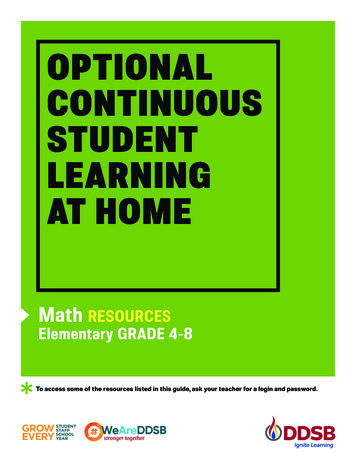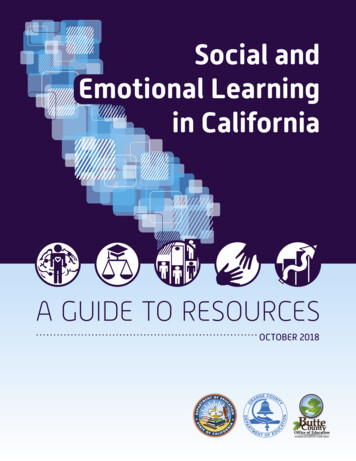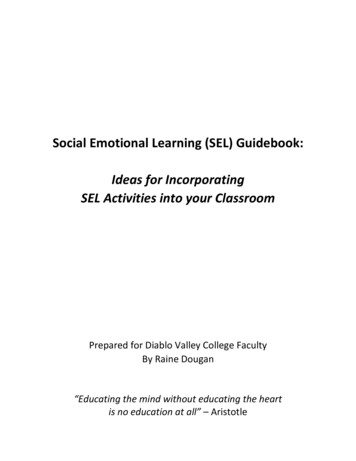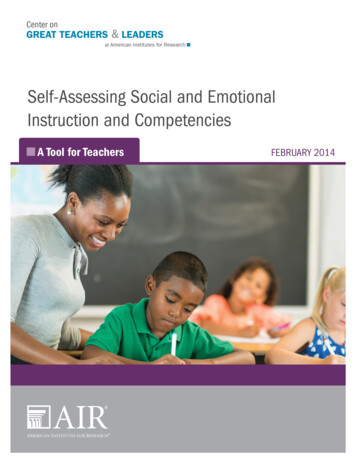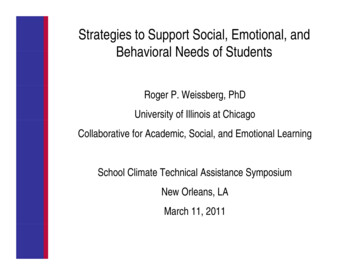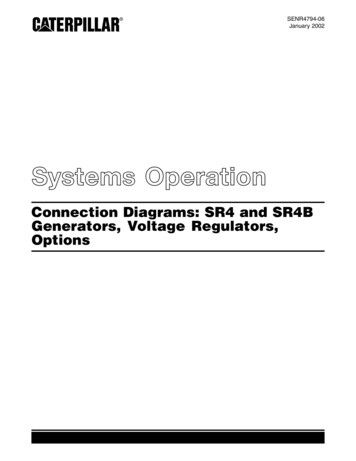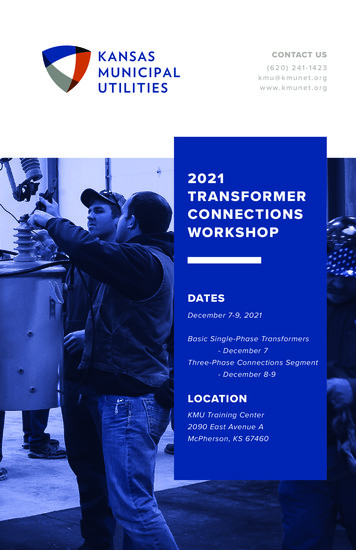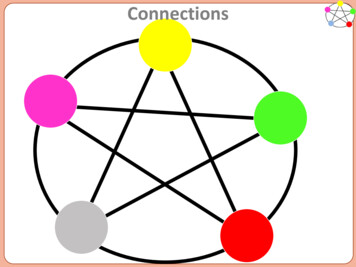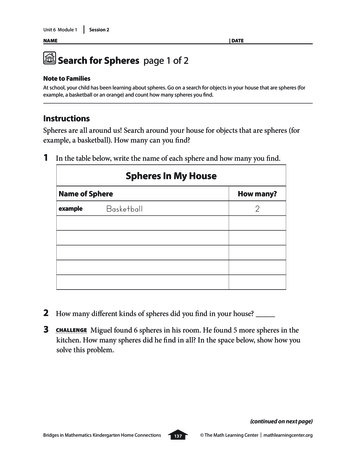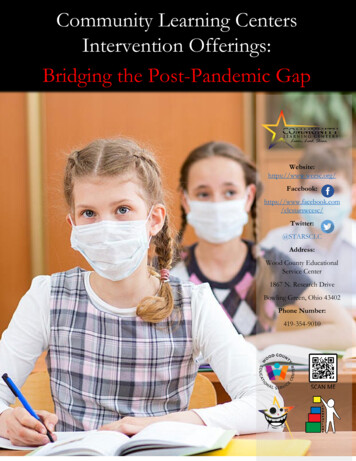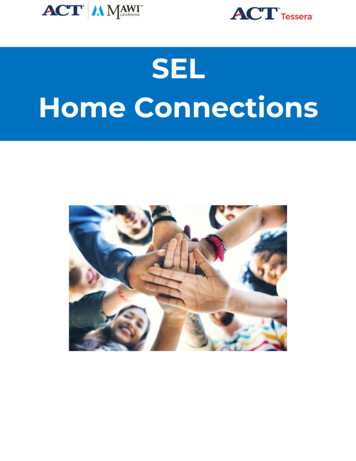
Transcription
SELHome Connections
SEL Home ConnectionsDear Teachers,We hope these activities can help you introduce social emotional learningtools to your students during this time.This packet contains 6 home connection activities for Turbo Leader SELmodules: Turbo, Relationship, Mindset, Skill, Voice, and Impact. Each of thehome connections includes letters to parents and families that describe thesocial emotional learning tool and provide ideas for increasing learning athome.These letters are designed to be guides but feel free to edit them to suit theneeds of your classroom, students, and parents.Parents and families are huge resources for the social-emotional journeythat your students are on. Bring them in as mentors, as discussionfacilitators, and as panelists. If it works for your classroom, consider having a“Family Share Day” where students and families talk present their work. Thisis especially great if you do the Impact Project for the final module.Thank you for your work and all your care for your students,ACT SEL Team
Choose the Best Turbo Plan:Home ConnectionDear Families,This letter is going to introduce your student to their “Turbo Buttons.” TheTurbo Button is a metaphorical button that symbolizes our willingness totake action to improve our lives and the lives of others. When we face aproblem or a challenge, we can hit our Turbo Buttons and take action toimprove the situation. We are learning how to identify at least two differentways to solve a problem, and then choose the best Turbo Plan. Yourstudent can identify one challenge that they face, identified at least twodifferent ways to solve the problem, and selected the best Turbo plan. Nowit is time to implement the plan!There are lots of ways you can help with this at home. Here are a few ideas: Ask your student to share their Turbo Plan with you. Support them inimplementing the steps in the plan. Ask your student about thedifferent plans s/he considered. Why did they choose this plan? If your student faces a problem or challenge at home, help themgenerate multiple strategies to solve the problem. Prompt yourstudent to choose the best Turbo plan with questions such as: Is your plan likely to be effective? Why or why not? Is your plan safe? Why or why not? Is your plan kind? Why or why not? Use the chart below to help your student practice choosing the bestTurbo Plan.Thank you for your support!
Choose the Best Turbo Plan: PracticeName:Describe your problemDate:Turbo Plan ACircle the best Turbo Plan. Why did you choose this plan?Turbo Plan B
Compromise is You and Me:Home ConnectionDear Families,For the relationships lessons, we are practicing the very important skill ofcompromise. First, we brainstormed times when we might have a conflictwith a friend or a family member. It’s natural that sometimes we want onething and a friend or family member wants something different. We canuse the Me and You Circles to find solutions that are balanced between ourown interests and the interests of others.Your student can identify one situation in which they frequently disagreewith a friend or family. They can a plan for how they will use their Me andYou Circles to compromise the next time they have a disagreement.There are lots of ways you can help with this at home! Here are a few ideas: Ask your student to share their plan to compromise using the Me andYou Circles. Help your student recognize situations at home that in which theycould compromise using the Me and You Circles. You can use the Meand You Circles images attached to guide your conversation.Thank you for your support!
My Compromise PlanName:Date:Think of a real-life situation in which you could compromise. Make aplan for how you will compromise.People InvolvedWhat each person wantsHow can you compromise?Me and You Circle if theperson gets what theywantMe and You Circle
Visualize. Draw a picture of yourself making this compromise.
Make Mistakes to Grow Your Can Do: Home ConnectionDear Families,Here, we will explore the concept of Growth Mindset (Carol Dweck, 2006). People with afixed mindset believe that intelligence and other abilities are fixed -- you either have itor you don’t. People with a growth mindset believe that, through hard work andsustained effort, you can grow your abilities and skills. Research has shown thatstudents with a growth mindset consistently outperform their peers.To help students build a growth mindset, you can work on reframing “I can’t”statements as “Not Yet” statements and explored the idea of Can Do Circles (skills youhave already mastered) and Not Yet Circles (skills you have not yet mastered). We focuson how we can use our mistakes as learning opportunities to grow our Can Do Circles.Your student has made a plan for how they can use mistakes to grow their Can DoCircle. They selected a situation in which they thought they might make a mistake andplanned how they could learn from that mistake.There are lots of ways you can help with this at home! Here are a few ideas: Ask your student to share their plan with you. Ask questions to encourage themto explain how they will use mistakes to grow their Can Do Circle: What situation did you choose? What kind of mistakes do you think youmight make? How will you use your next mistake to grow your Can Do Circle? Help your student notice opportunities to use mistakes to grow their Can DoCircle. If your student makes a mistake at home, celebrate the mistake as anopportunity for them to grow their Can Do Circle. Help them fill in the attachedchart to keep track of how they use their mistakes to grow their Can Do Circles.Thank you for your support!
Make Mistakes to Grow Your Can Do Circle!A mistake Imade.How I usedthemistake togrow myCan DoCircleMy Can Do/Not Yet Circlebefore the mistakeMy Can Do Circle now
Setting Goals for Building Skills: Home ConnectionDear Families,With MAD goals, we learned a key strategy in our Learning Toolkit setting goals for success. We have learned that our goals need to beMeasurable, Attainable, and Deadline-Driven in order to makethem strong goals.There are lots of ways you can help with this at home! Here are a fewideas: Make a MAD goal with your student and follow through!Commit to spending 10 minutes per day on your goal and talkabout your progress with your student. You may wish to selectand share your own, personal MAD goal or to work on creatinga shared one with your student. Some examples might include: Reading a book for 20 minutes every Training to run/walk a 5K Reducing phone usage Volunteering If you or your student doesn’t meet a goal, model the behaviorof checking where things went off-track, learning from ourmistakes without negative self-talk, and planning for how tosucceed in the future Fill out the attached Instant vs. Lasting zone sheet with yourstudent and for yourself. Were there activities in the instantzone that could be moved to help build toward your goal?Thank you for your support!
Instant Zone vs. Lasting ZoneExample:TimeActivityZone4:00-5:30pmPlay games on an appInstant Zone5:30-6:00pmFinish my math homeworkLasting ZoneDay:TimeActivityZone
Find Your Voice: Home ConnectionDear Families,We can find our sunlight in our lives by finding areas that maximize eachperson’s strengths and interests. We call these strengths and interests ourpassions. We can start by identifying our unique strengths and interests.There are lots of ways you can help your student learn to Find their Voice athome! Here are a few ideas: Ask your child about their passions. What gives them energy? How dothey feel when they are energized? What can you do to help them“find their sunlight” more often? Talk with your student about autonomy and freedom. Where do theyfeel they have enough freedom? Not enough? What could they do toearn more autonomy in their lives? Complete the values activity with your student. Instructions are on thefollowing page. Talk about why you picked the values you did andhow your values are similar or different from your child’s values.Thank you for your support!
Find Your Voice: ValuesDirections: Circle three values that matter the most to you in your life.Step 1: Talk with your partner about your values. Share and compare. Why did you choosethose values?Step 2: Now, choose only one of those three values to be your primary value. Why is thatvalue the most important to you?
Expand Your Impact: Home ConnectionDear Families,In Impact, your student can learn how to use their leadership skills toimpact others. Your student can practice improving their own life with theirTurbo tools, and now they are working on how to help improve the lives ofthose in their family, community, and world. This is where students areapplying everything that they’ve learned over their leadership journey andputting it into practice.There are lots of ways you can help your student learn to Expand theirImpact at home! Here are a few ideas: Talk to your student about how they can impact their family. What dothey already do to be helpful? Are there ways they can do more? Plan a group project with your family (and friends of the family if youlike). Use the planning sheet to identify each family member’s uniqueinterests and talents, and then plan how you will combine yourpassions to maximize your success. Think about how your project willbenefit your family, your community, and your world!Thank you for your support!
Impact Project: PlanPlan how you will combine your family and friend’s passions to create an impact.NamePassions (Strengths andInterests)Jobs
This packet contains 6 home connection activities for Turbo Leader SEL modules: Turbo, Relationship, Mindset, Skill, Voice, and Impact. Each of the home connections includes letters to parents and families that describe the social emotional learning tool and provid

